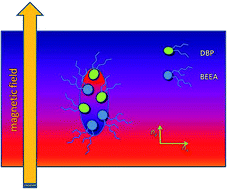Nano-demixing as a novel strategy for magnetic field responsive systems: the case of dibutyl phosphate/bis(2-ethylhexyl)amine systems†
Abstract
Pure surfactant liquids and their binary mixtures, owing to the amphiphilic nature of the molecules involved, can exhibit nano-segregation and peculiar transport properties. The possibility of opportunely choosing the amphiphiles should lead to the formation of anisotropic aggregates that can be oriented by an external factor like a magnetic field. In this case some properties, like optical birefringence, can be induced by the use of a magnetic field. Dynamic features of dibutyl phosphate (DBP)/bis(2-ethylhexyl)amine (BEEA) mixtures have been investigated by FT-IR, NMR, rheometry, Brillouin scattering, and magnetically-induced birefringence measurements as a function of the BEEA mole fraction (X). It turns out that BEEA/DBP liquid mixtures, driven by H-bond formation, show zero-threshold percolating self-assembly with a maximum in viscosity and a minimum in molecular diffusion at 1 : 1 composition. Interestingly, it has been highlighted that nano-segregation takes place at X ≅ 0.7 with the formation of DBP-rich closed local structures that are fully-responsive to an external magnetic field, rendering the system birefringent. It is worth noting that this is the first observation of amphiphile-based micelles in amphiphilic medium. The analysis of all the experimental data consistently pointed out the microscopic factors involved in this peculiar phenomenon and in particular emphasized the role of specific polar and apolar interactions along with to steric effects in regulating the molecular organization in surfactant mixtures. This report presents novel clear, stable and anhydrous systems, fully responsive to a magnetic field with tunable optical birefringence, and opens new trends in the directed design of water-free optically-active fluids.


 Please wait while we load your content...
Please wait while we load your content...